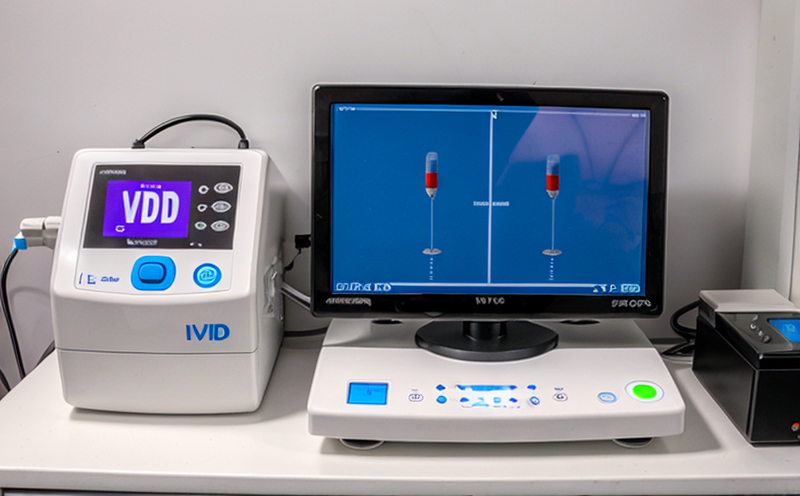Carryover Studies in Automated IVD Systems
In vitro diagnostic (IVD) devices are essential tools used by healthcare providers to make accurate diagnoses and treatment decisions. The reliability of these tests is critical, especially when dealing with complex automated systems that process multiple samples sequentially or simultaneously. Carryover studies in automated IVD systems ensure the integrity of test results by quantifying the potential for residual analytes from one sample to affect subsequent analyses.
Carryover, also known as carry forward, refers to the transfer of materials, particularly analytes, between different specimens processed on the same instrument. This phenomenon can lead to false positive or negative results if not properly addressed, especially in high-sensitivity assays common within IVD systems. Conducting these studies is mandatory for ensuring compliance with regulatory requirements and maintaining patient safety.
The primary goal of carryover studies is to demonstrate that residual materials from one specimen do not influence the performance of subsequent analyses on automated instruments used in clinical laboratories. These tests typically involve a series of spiked samples, where known concentrations of target analytes are introduced into the system at various points during operation. By monitoring both the initial and final results of these spiked samples, researchers can assess whether carryover has occurred and determine its magnitude.
Automated IVD systems present unique challenges due to their continuous operation and high sample throughput. As such, they require robust protocols designed specifically for detecting even trace amounts of residual materials between runs or batches. Regulatory bodies like the U.S. Food and Drug Administration (FDA), European Commission, and International Organization for Standardization (ISO) provide guidelines on how these studies should be conducted.
For instance, ISO 13428 specifies the general requirements for in vitro diagnostic medical devices, including those related to carryover effects. This standard outlines key aspects such as selection of reference materials, design considerations, and interpretation methods necessary when performing carryover evaluations on automated systems. Additionally, FDA’s Guidance for Industry: Evaluation of Carryover Effects provides specific recommendations tailored towards U.S. market requirements.
To conduct a successful carryover study, it is crucial to consider several factors including sample preparation techniques, instrument configuration settings, and environmental conditions under which testing takes place. Each factor can significantly impact the outcome, so careful planning is essential to ensure accurate results. For example, some instruments may have built-in features aimed at minimizing carryover risks; understanding these capabilities and how they influence overall performance is vital for interpreting study findings correctly.
A typical carryover study involves several steps: selecting appropriate reference materials, preparing spiked samples according to specified concentrations, running the instrument through its normal operating cycle while incorporating the spiked samples at designated intervals, collecting output data from both pre-spiked and post-spiked runs, analyzing this data using statistical methods such as paired t-tests or analysis of variance (ANOVA), and finally reporting any detected carryover effects along with their respective magnitudes.
Understanding the impact of carryover on IVD device performance is particularly important given recent advancements in molecular diagnostics where even minute quantities of residual materials could potentially lead to significant errors. Therefore, thorough evaluation using well-established methodologies becomes indispensable for maintaining high-quality standards within clinical laboratories worldwide.
Industry Applications
| Application Area | Description |
|---|---|
| Molecular Diagnostics | In molecular diagnostics, where assays are highly sensitive to even small amounts of residual materials, carryover studies help ensure accurate detection and quantification. |
| Blood Glucose Monitoring Devices | For glucose meters used in home healthcare settings, minimizing carryover helps prevent incorrect readings which could affect patient management decisions. |
| Clinical Chemistry Analyzers | In clinical chemistry analyzers that process multiple samples daily, carryover studies are essential for maintaining consistent and reliable test results over time. |
| Microbiology Systems | For microbiological testing systems where cross-contamination between different organisms could lead to misdiagnosis or treatment failure, carryover evaluations ensure optimal performance. |
- Molecular Diagnostics: High sensitivity assays require stringent measures against carryover to avoid false positive/negative results.
- Microbiology Systems: Preventing cross-contamination between different microorganisms is critical for accurate identification and subsequent treatment.
Quality and Reliability Assurance
- Selection of Appropriate Reference Materials: Using precise, stable reference materials ensures consistent results across multiple runs.
- Instrument Configuration Settings: Proper setup parameters reduce the likelihood of carryover occurring during sample processing.
Regular calibration and maintenance of automated IVD systems play crucial roles in maintaining quality assurance. Regularly scheduled checks help identify potential issues early on, allowing for timely corrective actions before they escalate into more serious problems affecting test accuracy and reliability. Additionally, implementing standardized operating procedures (SOPs) provides consistency among operators performing carryover studies, reducing variability due to individual differences.
Compliance with relevant standards such as ISO 13428 ensures that the methodologies employed meet industry best practices. Adhering to these guidelines helps maintain credibility and trustworthiness within regulatory bodies and enhances overall reputation among stakeholders involved in healthcare provision.
International Acceptance and Recognition
The importance of carryover studies extends beyond national borders, given that many countries recognize the significance of this issue when evaluating IVD devices. Regulatory authorities worldwide have established frameworks governing these evaluations to ensure uniformity across different markets.
In Europe, Directive 98/79/EC on In Vitro Diagnostic Medical Devices mandates manufacturers to perform carryover studies as part of their quality assurance processes. Similarly, the U.S. Food and Drug Administration (FDA) requires similar assessments under its Guidance for Industry: Evaluation of Carryover Effects. Both regulatory bodies emphasize the necessity of these studies in ensuring product safety and efficacy.
Recognition from international organizations like the International Organization for Standardization (ISO) further strengthens the importance placed on carryover evaluations. ISO 13428 specifically addresses the topic, providing detailed instructions that guide manufacturers through conducting thorough assessments. Compliance with such standards not only facilitates easier market access but also enhances confidence among users who rely heavily upon these diagnostic tools.





